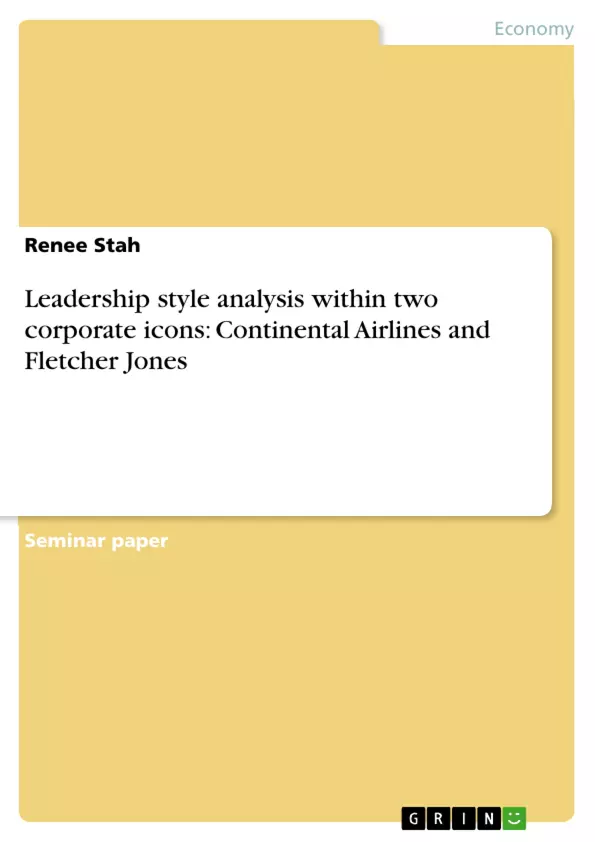The strengths and weaknesses of two corporate icons, Continental Airlines and Fletcher Jones and Staff will be analysed in this case study using various theories and frameworks to compare the two companies, with particular attention to contrasting the different leaders in each and where their approaches and leadership styles proved service or disservice to the success of their organisations. The key frameworks covered are: Drucker’s (1994) Theory of Business, Quinn et al’s (2011) Competing Values Framework, Nohria et al’s (2003) 4 + 2 Formula for Business Success and Kouzes and Posner’s (2002) The Five Practices of Exemplary Leadership. In order to differentiate Fletcher Jones the man in this case study, the company will be referred to as it was originally named, Fletcher Jones and Staff.
Quoted in relevant areas of the case study is Anthony Robbins, who is considered a world authority on the psychology of leadership and organisational turnaround.
Inhaltsverzeichnis (Table of Contents)
- 1. INTRODUCTION
- 2. SYNOPSIS
- 2.1 CONTINENTAL AIRLINES
- 2.2 FLETCHER JONES
- 3. THEORY OF BUSINESS
- 3.1 CONTINENTAL AIRLINES
- 3.2 FLETCHER JONES
- 4. COMPETING VALUES FRAMEWORK
- 4.1 HUMAN RELATIONS MODEL - COLLABORATE
- 4.2 OPEN SYSTEMS MODEL - CREATE
- 4.3 INTERNAL PROCESS MODEL - CONTROL
- 4.4 RATIONAL GOAL MODEL - COMPETE
- 5. 4+2 BUSINESS SUCCESS FORMULA
- 5.1 CONTINENTAL AIRLINES
- 5.2 FLETCHER JONES
- 6. THE FIVE PRACTICES OF EXEMPLARY LEADERSHIP
- 6.1 CONTINENTAL AIRLINES
- 6.2 FLETCHER JONES
Zielsetzung und Themenschwerpunkte (Objectives and Key Themes)
This case study analyzes the strengths and weaknesses of two prominent companies, Continental Airlines and Fletcher Jones and Staff, utilizing various theories and frameworks. It compares the approaches and leadership styles of key individuals in each organization, exploring how these elements impacted their success. The study focuses on Drucker's Theory of Business, Quinn et al.'s Competing Values Framework, Nohria et al.'s 4+2 Formula for Business Success, and Kouzes and Posner's The Five Practices of Exemplary Leadership.
- Leadership styles and their impact on organizational success
- The importance of a coherent theory of business aligned with environmental realities
- The application of different leadership frameworks in real-world scenarios
- The role of culture and values in organizational performance
- The challenges of leading through organizational change and turnaround
Zusammenfassung der Kapitel (Chapter Summaries)
- Introduction: This chapter introduces the case study, outlining its focus on Continental Airlines and Fletcher Jones and Staff, highlighting the leadership styles and frameworks to be analyzed. It also mentions the key figures and the company's name change for clarity.
- Synopsis: This section provides a brief overview of the two companies. It describes Continental Airlines' financial struggles and their eventual turnaround under new leadership. It also introduces Fletcher Jones and Staff, outlining its initial success as a workers' cooperative and its later challenges in the face of changing market conditions.
- Theory of Business: This chapter explores Drucker's (1994) theory of business, which emphasizes the importance of aligning a company's assumptions about its market, customers, competitors, and its own strengths and weaknesses with reality. It analyzes how Continental Airlines initially failed to consider the needs of its customers and how Brenneman and Bethune subsequently implemented a successful strategy based on customer feedback and market realities.
Schlüsselwörter (Keywords)
This case study focuses on leadership styles, organizational success, business theory, competing values framework, 4+2 formula for business success, and exemplary leadership practices. Key themes include organizational turnaround, strategic alignment, cultural change, and the impact of leadership on organizational performance.
- Arbeit zitieren
- Renee Stah (Autor:in), 2012, Leadership style analysis within two corporate icons: Continental Airlines and Fletcher Jones, München, GRIN Verlag, https://www.grin.com/document/274921



